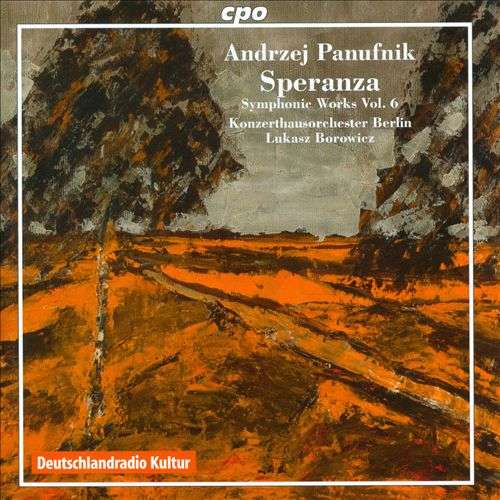|
Back
08/23/2013
Andrzej Panufnik: Concertino for Timpani, Percussion & Strings – Symphony No. 9, "Sinfonia di Speranza"
Michael Oberaigner (Timpani), Christian Löffler (Percussion), Konzerthausorchester Berlin, Lukasz Borowicz (conductor)
Recorded at: Konzerthaus Berlin (November 2011) – 58'38
CPO 777 685-2 – Booklet in English, German and Polish

   
This disc, the sixth in CPO's series of Andrzej Panufnik's orchestral works, is an excellent pairing. The two works could not be more contrasting or more complementary: the Concertino in its five separate, bite-size chunks and the Ninth Symphony in its continuous 40-minute span. Both works are not concert hall staples, and may never become so. The Symphony's work's length and intensity certainly make it a hard work to program and for audiences to appreciate on one listen, while the Concertino might suffer the opposite fate: too brief to "justify" the gathering together of two soloists and an arsenal of percussion equipment. Panufnik himself recorded the Symphony (on RCA's now-defunct Catalyst label) and both that and the present recording make an excellent testament for an underrated 20th-century essay in the symphonic genre.
The Concertino moves quickly through its five movements, each timbrally distinct. Panufnik composes with tiny generative ideas (in this case, a four-pitch motive) that, in his best works, reveal an extraordinary, Beethoven-esque ability to spin infinite variety from limited means. Perhaps this concertante work doesn't quite approach the composer's greatest, but it does contain many wonderful, evocative moments. The fourth movement ("Canto II") is a particularly haunting essay, with strings presenting a dissonant but not disorienting chorale that is commented upon by glockenspiel statements. Immediately impressive is Christian Löffler's ability to draw large dynamic gradation and consistency from glockenspiel and chimes (at the opening of the work), the latter caught in awesome sound, overtones richly present. The final movement ("Fine") may seem a bit rote, with tom-toms and timpani engaging in vigorous battle, and the ending is shockingly abrupt, but this is an easily digested introduction to the mammoth work that rounds out the disc.
Calum MacDonald aptly describes the Sinfonia di Speranza as a "giant chaconne" and the idea of constancy and change provide the momentum for the work. Panufnik again creates the work out of an small germ, this time a motive of three pitches, from which he set himself "the formidable task of composing a continuous melodic line of about forty minutes duration." Those forty minutes require devout attention, but the payoff--a true feeling of of the titular "hope," though not untainted by the shadow of oppression the composer knew so well--is great. Lukasz Borowicz manages the behemoth structure with assurance, and the Konzerthausorchester Berlin plays wonderfully. The strings in both works are full and rich from top to bottom, and there are wonderful wind solos in the symphony, especially a lengthy duet between oboe and bassoon, perfectly in sync. It is helpful to think of the symmetry that preoccupied Panufnik when composing this work (the intricate structure is devised from a rainbow), and after a few listens is becomes easy to recognize returns and anticipate familiar gestures, even with the never-ending, continuous melodic unfolding that is going on above.
Recorded sound spotlights the soloists in the Concertino, but this makes the fast movements extraordinarily visceral and exciting, while allowing us to hear the aforementioned dynamic gradations with ease. The symphony, too, is finely detailed but seems to be captured a bit further off, adding a halo to the many sustained slow sections in the work that making them all the more haunting. Biographical and program notes are extensive and well-written, the latter drawn largely from the composer's own copious writings about his music.
Listeners familiar with Panufnik's music will find much to love here, as will those with an interest in 20th-century symphonic writing. For those taking the plunge for the first time, it might be easier to start with the composer's justly popular Third Symphony (the Sinfonia Sacra), which has received many fine recordings, but given appropriate attention and time, this disc will pay great dividends.
Marcus Karl Maroney
|